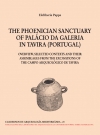 |
 |
 |
 |
ISBN 13:
978 84 7290 741 6
Rústica
56 págs.
Edición: 2015
23
|
|
 |
|
 |
THE PHOENICIAN SANCTUARY |
|
| |
INTRODUCTION
The Phoenician colony in Tavira (municipality of Tavira, district of Faro, Algarve) in southern Portugal is known through a series of articles documenting in overview format the Iron Age occupation of the area, a Phoenician colony. The excavation of a space interpreted as an intra-mural sanctuary stands out as particularly important given that urban sanctuaries are almost absent from the Phoenician colonies in Iberia, especially in Portugal where most sites identified as urban sanctuaries lack any architectural documentation.
Tavira is located close to the estuary margin of the river Gilão/Seco, on the Gulf of Cádiz, immediately west from Cádiz, the location of the famous ancient Phoenician colony of Gadir. The stretch of the coastal area from the Straits of Gibraltar and northwards up to Figuiera da Foz (District of Coimbra) has yielded evidence for varying degrees of Phoenician involvement (Fig. 1).
A series of rescue excavations in Tavira was initiated at the request of the municipality of Tavira, undertaken by the non-profit organisation Associação Campo Arqueológico de Tavira (henceforth: CAT) and by private archaeological companies commissioned by the municipality. The CAT conducted rescue excavations in the historic centre of Tavira in 1998-2002 directed by Maria Maia, under the aegis of the then Institute of Archaeology (IPA) of Portugal. At the time, the municipal archaeological service of Tavira, entrusted with the identification, excavation and restoration of archaeological heritage, did not exist. Maria Maia worked with a minimal number of staff given limitations in resources. Although the results of the excavations by the CAT were disseminated in overview publications (intended as preliminary to full publication), only a tiny fraction of the excavated material was published and presented to the public in the context of temporary museum exhibitions (e.g. at the National Museum of Archaeology in Lisbon). The bulk of the finds remained unprocessed and unstudied following the untimely death of the director of the excavations, Maria Maia, and the subsequent dissolution of the CAT in 2011.
Excavations by the CAT ran concurrently at different localities on the hill of Santa Maria: at the site of the old Corte-Reais palace and under a neighbouring building («Netos site»), and inside the 16th century BC building of the Palácio de Galeria (henceforth: PG). These localities comprise essentially a site-cluster, formed by sites geographically close but separated by modern infrastructure and buildings, which prevented the investigation of large, open spaces (Fig. 2). The excavations brought to light parts of the urban nucleus of the Phoenician colony, including a section of a fortification/city wall of truly monumental dimensions, occupation deposits and evidence for metallurgical activities. The excavator, Maria Maia, dated the earliest evidence to the 8th century BC.
The area inside the PG building yielded artificial, interconnected pits that the excavators interpreted as ritual, artifical pits/channels, bothroi. In terms of interpretation, the PG site remains the most problematic of the site-cluster. Earlier interpretations while the excavations were ongoing saw these structures as water cisterns, subsequently as funerary monuments. From the latter interpretation, the descriptive name «tumulus» was used not only in the field reports and labeling of finds, but also in some of the preliminary publications. Here the word «Tumulus» (capitalized) will be used to refer to one of these structures to avoid confusion, as the name persisted, even if the interpretation of the featre as a funerary monument can be no longer sustained.
In the present paper, the aim is to present a preliminary report on the excavations carried out at the site of the PG in Tavira based on the study of the excavations archives, of the diagnostic finds kept at the Museu da Lucerna (Castro Verde) and of the bulk of finds stored at the archaeological stores of the municipality in Tavira.
First a summary of the results of excavations in Tavira, as they pertain to the Phoenician colony, will be given. These are based on short articles on the excavations, on other publications on the archaeology of Tavira and on visits to the sites and its environs. I will then begin the study of the PG site with a section on methodology followed and the problems entailed in reconstructing the excavations from the extant archives. Then a report of the excavations carried out inside the building will be given, after a summary of the published information on the PG site. This will be followed by a more detailed focus of certain contexts, especially Tumulus II, as reconstructed from Maria Maia’s archive and finds. Preliminary results will revisit the old hypothesis of the site as a sanctuary, examining it in the context of more recent excavations of western Phoenician sanctuaries, e.g. the Carambolo sanctuary annex (Seville) and the so-called kothon temple in Motya (Sicily). The intention is that this preliminary report will be followed by a second report on the material from Pit/Tumulus I. |
| |
| |

|